The following is an unofficial English translation of a Japanese article about the history of light novels by a group called the Light Novel Research Institute. It is presented here for educational and research purposes only. The original Japanese text can be found here. This is an edited machine translation, so some titles or names may be incorrect.
Summary of the 1980s
The 1980s was a time when TRPGs, such as Dungeons & Dragons, and fantasy RPGs, such as Dragon Quest, exploded in popularity. Against this background, TRPG replay novels such as “Record of Lodoss War” and the masterpiece “Fortune Quest,” which adopted a game-like worldview, were born.
In the late 80’s, fantasy novels replaced science fiction novels, and from then until the late 90’s, light novels were all about otherworldly fantasy with swords and magic, entering what could be called a fantasy bubble.
Also, during this era, writers from anime scriptwriters and game magazines like “Comptiq” were used to create novels for middle and high school students. It was hard to secure writers, and publishers struggled to keep up with the growing demand for novels, forcing fast writers to use multiple pen names and publish more than two books a month, or asking male writers to write novels for girls.
Cobalt Bunko and Fujimi Fantasia Bunko were among the first to hold the Light Novel Newcomer Award, a gateway to success for newcomers, and to focus on discovering promising newcomers.
In the latter half of the 20th century, many labels for girls started up, perhaps following the success of Cobalt Bunko, but all of them ended up being short-lived except for Kodansha X Bunko Teen’s Heart. This shows how tough it is to succeed in the light novel industry, even in a booming economy.
Table of Contents:
1980
First publication of a label
- The publishing company Bunka Publishing Bureau launches the “Pocket Mates” label (~1982).
- The label’s focus was the novelization of anime. This was probably a response to the success of the Gundam novelization.
Representative works

- The first book in the Dirty Pair series, “The Dirty Pair’s Great Adventure”, a science fiction adventure story by Takachiho Haruka, was published by Hayakawa Bunko JA.
- The heroines are 19 years old, which is older than most modern (as of 2012) novels, and the image of the heroine is more sexy than moe.
- This work shared the same worldview as “Crusher Joe,” which was also illustrated by Yoshikazu Yasuhiko.
The Birth of Sister Moe

“Miyuki”, a manga by Mitsuru Adachi, was serialized in the shonen manga magazine “Shonen Big Comic”.
It is a coming-of-age love comedy that depicts a love triangle between the protagonist, his classmate Miyuki, a beautiful girl he admires, and his sister Miyuki, a non-blood related girl he has not seen in six years. The protagonist, who is now living alone with his younger sister Miyuki, becomes aware of her as the opposite sex and is troubled.
The protagonist is a mirror image of a sis-con man who eventually marries his non-blood related sister.
1981
Trends in the game industry
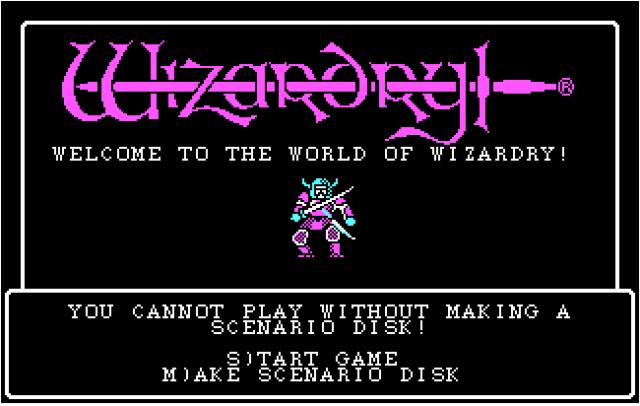
- The first computer-based fantasy RPG, Wizardry, was released by Sir-Tech in the United States.
- The concept of this game was to recreate the TRPG (Table Top RPG) game “Dungeons & Dragons” on the computer.
- The Japanese version was released for the PC in 1985, and since then it has been so popular that it has become a series.
1982
First publication of several labels
Tokuma Shoten launches “Anime Bunko”. Abbreviated as AM Bunko (~1998)
- The label was based on the anime boom and mainly focused on anime novelization, employing anime scriptwriters as writers.
- It also novelized Hayao Miyazaki’s “Castle in the Sky” (1986/5) and “My Neighbor Totoro” (1988/4).
- The company closed its doors in 1998 in favor of newer labels, but would return in July 2009.
Shueisha launches “Cobalt,” a bimonthly magazine for girls, which is a revival of the magazine “Shosetsu Junior”. It publishes novels for girls.
Kodansha launches “Kodansha Novels”. It is a new book label that mainly publishes mystery novels represented by Jiro Akagawa, but it later publishes novels classified as light novels, such as Kinoko Nasu’s “Kara no Kyoukai” (2004/6) and Ishin Nishio’s “Shojo Sufficient” (2011/9).
Representative works

The “Legend of the Galactic Heroes” series of science fiction novels by Yoshiki Tanaka was launched.
The series has sold over 15 million copies in total and continues to be a super long seller as of 2012.
A space opera about a war between two major powers, the Galactic Empire and the Alliance of Free Planets, set in a far future universe, depicting the exploits of many heroes with the two main characters, Reinhard von Loengram and Yang Wenli, at the center.
The story is like a medieval tale in space, with Reinhardt, a war genius, overthrowing the corrupt Galactic Empire from within and usurping the throne. On the other hand, the story depicts the exploits of Yang, a wise general who is forced to fight against the Galactic Empire as a victim of dirty democratic politics, and the fatal battle between himself and Reinhardt.
The covers of the books were mainly depicting spaceships and weapons with a touch of anime. The illustrations were also few, and were cartoon-style illustrations with a realistic touch.
However, the content was too advanced for teenage boys and girls to read, with difficult themes such as “Which is better, a clean dictatorship or a corrupt democracy?” It required a certain level of education to enjoy the difficult themes of Machiavellianism, economics, and ironic black humor. The target age group is over 20 years old. It has been made into animated feature films and OVAs.
The characterization of Yang as a genius in strategy and tactics, but as a totally useless person with no selfishness other than that, has influenced later novels and anime such as “Irresponsible Captain Tyler” (a novella published in January 1989) and “Mobile Battleship Nadesico” (an anime broadcast in October 1996).

Hideyuki Kikuchi’s debut novel “Demon City Shinjuku” was published by Sonorama Bunko.
While set in the real world, it is a forerunner of modern urban fantasy with fantasy elements such as demons, strange phenomena, and mages in a modern setting.
The first book in Baku Yumemakura’s “Kimaira Kou” series, “Genjyū Shōnen Kimaira” [Beast Boy Chimera] is published by Sonorama Bunko.
This is a magnificent novel that depicts the strange fate of Taiho Roark, a weak and beautiful boy who has a body that turns into a chimera. It is a novel for late teens with “erotic” and “violent” elements, and is said to be the origin of the school genre.
Trends in the Bishojo Game Industry
- The birth of bishojo games (eroge) for PCs.
- The first bishojo game (eroge) for PCs was “Night Life” developed by Koei Microcomputer System (now Koei Tecmo Games).
- Since then, bishojo games have had a close influence on light novels.
1983 Birth of the Term “Otaku”
Newcomer Award
Shueisha launches its first light novel newcomer award, the “Cobalt Novel Award”.
- The final selection was announced in the spring 1983 issue of Cobalt magazine.
- No work was selected, but an honorable mention was given to Yoshiko Hitotsugi (age 21), author of “For example, in my album when I was 19.” Also, the author of “Saint Vegetable Day”, Katayama Mitsuhisa (age 17), was a young woman, just like the target readership.
- The proximity of the age groups of the new writers and the readers has been a trend seen in the light novel newcomer awards since then, and is one of the characteristics of novels.
Representative works
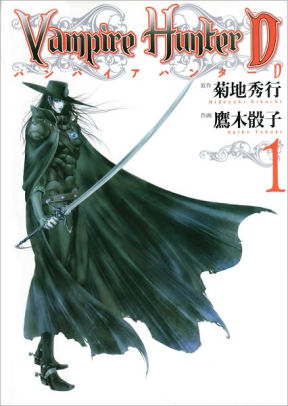
Hideyuki Kikuchi’s “Vampire Hunter “D”” was published by Sonorama Bunko.
It is a vampire story set in the future, and features a world view where super-science, super-power, and demons are mixed together.
It was the first fusion of science fiction and fantasy, and had a great influence on later vampire stories.
As of 2012, the series is still being published and is an extremely long seller.
Trends in the gaming industry
- The Japanese version of the TRPG “Starquest” was released, and the TRPG boom gradually accelerated.
- The first home video game console, the Family Computer, was released by Nintendo on July 15, 1983.
Birth of the term “otaku”
The term “otaku” was coined after Akio Nakamori wrote a series of articles called “A Study of ‘Otaku'” in the bishojo comic magazine Manga Brikko, in which adult men who liked anime, manga, and other children’s content referred to each other by using the word “Otaku.” At the time, the term “otaku” was written in hiragana.
1984
Representative works

Yuichi Sasamoto’s “Fairy Operation” was published by Sonorama Bunko.
It is a royal “boy meets girl” story in which the main character, a high school boy, meets a beautiful girl with supernatural powers who is being chased by a mysterious supranational organization, and struggles to save her. It is characterized by a fast-paced writing style that mainly uses conversational text.
For these reasons, it has been called the “origin of light novels,” and the author himself calls himself “the oldest active light novelist.”
This work was reprinted by Sogen SF Bunko in 2011, and its charm has not faded even after nearly 30 years.
Launch of a label
Kodansha launched “Kodansha X Bunko” (~1987).
- It was a label that published novelizations of manga and movies, as well as talent books, but it was short-lived.
Trends in the animation industry

Hayao Miyazaki’s animated film “Nausicaä of the Valley of the Wind” was released.
The original manga work was serialized in Animage from the February 1982 to March 1994 issues.
It is immensely popular, and even in the 2010s, it has been rerun on TV, and each time it gets high ratings.
However, according to Kazuma Shinjo’s book “Light Novel “Cho” Nyumon” (April 2006), Hayao Miyazaki’s series of anime works have had very little influence on light novels, and the reasons for this are unknown.
In my opinion, the reason may be that the protagonists of Miyazaki’s works are feminine girls who fight. With few exceptions, the protagonists of shonen labels are boys. This is because male readers are less likely to get emotionally involved if the main character is a girl. The main character of the smash hit “Slayers” (1990) is a girl named Lina, but she is a man inside. However, the character of Nausicaa in “Nausicaa of the Valley of the Wind” is infinitely feminine and resolves conflicts peacefully. Also, the heroine of Miyazaki’s anime “Castle in the Sky” (released in August 1986) is a weak and passive princess type, in contrast to the strong heroines of novels who get involved with the hero. This is not in line with the tastes of romance readers who want the girl to approach the hero.
In labels for girls, battles and wars are not depicted like in Nausicaa, and romance is the main focus. This is in contrast to Nausicaa, which is about war and has almost no romantic elements.
Miyazaki’s works may have had little influence because they did not match the tastes of light novel readers.
The reason for the lack of influence in the area of illustration is that Miyazaki’s animations were too famous and his designs were too unique to be copied poorly.

The second original feature film version of Rumiko Takahashi’s manga “Urusei Yatsura”, “Urusei Yatsura 2: Beautiful Dreamer”, was released on February 11 at Toho. The script was written by Oshii Mamoru.
It is a pioneering work in the time-loop genre where the day before the school festival is repeated.
Originally, “Urusei Yatsura” was a work that depicted a maternal utopia where the characters do not age forever, in contrast to the paternalistic robot anime that was popular from the 70s to the early 90s. The heroine Lum’s desire to keep her loved ones and happy days locked away forever creates a closed space-time, from which the hero tries to escape.
In contrast to Miyazaki’s anime, which has had little influence on light novels, this one has had a great influence. The structure of time looping became popular in bishojo games in the 2000s, and was also used in novels such as “Suzumiya Haruhi Series” (published in 2003) and “All you need is kill” (published in 2004).
1985
Trends in the novel industry
“Dirty Pair” was made into a TV anime by Sunrise Japan (now Sunrise).
This was the first TV anime adaptation of a light novel.
This work was made into an OVA in the same year, and a movie version was released in 1987. In 1987, a theatrical version was released, and the work was made into a video game, creating a media mix that led to a boom.
Kadokawa Shoten launched the anime magazine “Monthly Newtype” (aka Newtype).
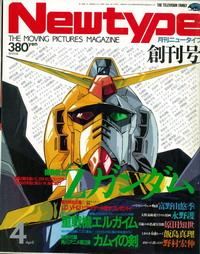
- It is a general culture magazine that includes information on music and live-action movies in addition to anime, as well as manga and light novels.
- Gaia Gear” (April 1987 to December 1991), a Gundam novel written by Mobile Suit Gundam director Yoshiyuki Tomino, was serialized and published as a book by Kadokawa Sneaker Bunko, which was later established.
- The first issue featured the sequel to Gundam, Mobile Suit Zeta Gundam, which was broadcasted from that year. The name of the magazine is also derived from the concept of Newtype, a new species that appears in Gundam.
The following is the cover image of the first issue. It is decorated with a close-up of Gundam MK-II.
Trends in the Manga Industry

In December, Masami Kurumada’s “Saint Seiya” begins serialization in Shonen Jump.
Based on Greek mythology, the story of two beautiful boys fighting each other wearing armor with special abilities has attracted not only boys but also girls, causing a boom in “yaoi doujinshi”, a genre that became the foundation for the rise of doujin anthology comics and BL in the 1990s.
It was also popular in China, and turned many women on to BL, leading to the birth of Fujoshi (腐女子, lit. “spoiled girl”) culture in China.
The concept of this work influenced the debut work “Tenku Senki Surato” [Legend of Heavenly Sphere Shurato] by Satoru Akahori, who created the “battlesuit” genre and is considered to be one of the founders of light novels.
1986
Influential Circumstances
The computer game magazine “Comptiq” published a replay of a “Dungeons & Dragons” campaign session, “Record of Lodoss War”, as an article introducing TRPGs. A replay was a record of a conversation between a game master and a player to introduce TRPGs, but it came to be enjoyed as reading material because of the various devices, direction, and editing that were used to make the content more interesting.
Representative works

In March, “Digital Devil Story: Goddess Reincarnation”, a bizarre SF novel by Aya Nishitani, was published by Animage Bunko.
The story is about a boy who is a genius programmer who summons a demon from his computer, and the people who are the reincarnation of the gods of Japanese mythology who fight against it. The story is dark and irredeemable, and is said to be the origin of dark light novels.
The series has sold over 800,000 copies in total. It has been made into a game as “Megami Tensei Series”, and the game series has been released in the 2010s. In addition to the Shin Megami Tensei series, it has influenced many other games such as Persona, Devil Summoner, Digital Devil Saga and Devil Survivor.
Trends in the gaming industry

“Dragon Quest”, the first fantasy RPG for the family computer, was released and became a huge hit. It is an orthodox mythological story in which a brave hero rescues a princess kidnapped by the Dragon King, the master of demons, and defeats the Dragon King.
This led to a fantasy boom.
“Dragon Quest” was also made into a novel by Enix in 1989, and became the forerunner of game novelization. There are hardcover and paperback editions.
1987
First publication of a label
Kodansha launched “Kodansha X Bunko Teen’s Heart” (~2006).
- A light novel label for girls, targeting middle and high school students, a slightly younger age group than Cobalt Bunko.
- The spine was pink, and the cover featured a gorgeous illustration by a shoujo manga artist, which was designed with the subscriber base in mind.
- The representative author was Aiko Hanai, who participated in the planning of the first issue. She was the “Queen of Girls Novels” who used three different pen names and published two books a month at a high pace.
- She became popular for her easy-to-understand stories filled with a girl’s dreams, and for her style that emphasized readability with many line breaks and margins on the bottom half of the page, laying the foundation for the modern light novel.
Trends in the Manga Industry

“JoJo’s Bizarre Adventure” by Hirohiko Araki began serialization in Shonen Jump.
The first part depicts the confrontation between Dio, who has turned into a vampire, and JoJo, the head of the Joestar family, who has acquired the ability of ripple to fight the vampire. The second part depicts the battle against a transcendent race that surpasses vampires.
However, from the third part in 1989, the story shifts to a battle of different abilities using stands (yūwamon), which are guardian spirit-like beings with their own unique psychic abilities. Stand battles have rules based on the nature of the stands, and tactics are required to find out the abilities of the enemy’s stands, counteract their strengths, and exploit their weaknesses.
- This is the forerunner of the “card game/battle royale type stories” that would flourish from the late 1990s.
- JoJo’s Bizarre Adventure” was groundbreaking in that it avoided the inflation of combat power and gave the characters abilities directly related to their personalities.
- The lineage of different ability battles would later give birth to the hit light novel of the 2000s, “Toaru Majutsu no Index” (published in 2004).
- (It is also said that the originator of the different ability battle is Masami Kurumada’s ninja manga “Fuuma no Kojiro” (1982).)
The first novelization of a game

In January, the game novelization “Dragon Buster” by Motohiko Izawa was published by Kadokawa Bunko.
Based on an action game for Namco’s arcades that came out in January 1985. It was later ported to the Famicom in January 1987.
The novel version is about Clovis, a master swordsman, who goes to Dragon Mountain to save Princess Celia, who was kidnapped by the Dragon People on the anniversary of the establishment of the Kingdom of Lawrence. It was a royal mythology-style story.
This is considered to be the first novelization of the game. The novel was very high quality.
Trends in the game industry

The PC game software company Nihon Falcom released the fantasy action RPG “Ys”.
This is the first installment of a very popular series that has become Falcom’s signature work, and the latest installment is still being released in the 2010s.
Lilia, the heroine of the sequel “Ys II” released in 1988, is known as the first character-based heroine in the history of PC RPGs. Lilia became so popular that a contest to find the image girl of “Lilia” called Miss Lilia Contest was held at Falcom Festival ’90 held at Shinjuku Lumine ACT on March 26, 1990. In “Ys II”, the emphasis was also placed on romance with beautiful girls, and the main character, Adol, had a loving relationship with the goddess Fina in addition to Lilia. It was one of the first games to introduce moe elements into fantasy and pioneered the moe genre.

In December of the same year, “Final Fantasy”, one of Japan’s most popular fantasy RPGs, was released by Square (now Square Enix). The second game in the series, “Final Fantasy II,” was released at the end of the following year, and the novel version, “Final Fantasy 2: Labyrinth of Dreamers,” was published by Sneaker Bunko in 1989.
The first Final Fantasy game book was published by Keibunsha Adventure Hero Books in December 1987 under the title “Final Fantasy: Crystal Inheritance Legend”. The story is set in a time before the game version, and leads up to the main game.
1988 Birth of a Label for Boys
First publication of a label
In September, Kadokawa Shoten launches “Kadokawa Sneaker Bunko”, which includes writers such as Yoshiyuki Tomino of the “Gundam Series”, Yusa Watanabe of “Heavy Metal L-gaim”, and Yukihiro Tomita of the “Macross Series”.
Fujimi Shobo launched “Fujimi Fantasia Bunko”.
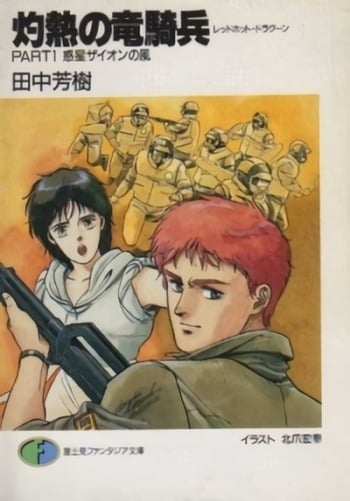
The first work published was “Red Hot Dragoon,” a science fiction novel by Yoshiki Tanaka, famous for “Legend of the Galactic Heroes.”
The Fantasia Full-length Novel Award (now the Fantasia Award) is launched.
The first monthly light novel magazine, Dragon Magazine (DM), begins publication.
In the early days of publication, there were many articles related to idols, and the ratio of novels to articles was about 50-50, with idols wearing cosplay on the cover. Below is the cover image of the first issue. After that, the cover was changed to an anime-style illustration, similar to the cover of a light novel style book.

Keibunsha launches “Geibunsha Bunko Cosmo Teens”. (-89)
- It was a label for girls, but it was discontinued the following year.
Shogakukan published Palette, a quarterly magazine of novels for girls.
- The catchphrase was “A magazine of love stories for cute girls.
Representative works
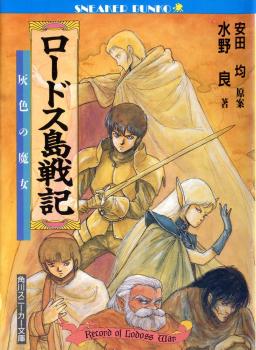
Ryo Mizuno published the first novel “Record of Lodoss War: The Gray Witch” from Sneaker Bunko (strictly speaking, Kadokawa Bunko, as this was published before Sneaker Bunko’s inauguration), which was based on a TRPG replay. It was a big hit and became a series. This was the start of the fantasy novel boom.
“Record of Lodoss War” became so popular that it was ranked in the top five in paperback sales until the late 1990s. This was followed by a TV anime in April 1998.
Ryo Mizuno (along with Hajime Kamisaka (Slayers) and Satoru Akahori (Sorcerer Hunter) is the founder of the light novel genre and one of the biggest sellers of the 1990s. The three of them are sometimes referred to as the “Three Gods of Creation.”
“Ys: The Lost Kingdom”, a novelization of Nihon Falcom’s popular fantasy action RPG “Ys”, was published by Kadokawa Bunko (before the launch of Kadokawa Sneaker Bunko). The author is Yoh Tobihino, who made his debut with this work.
- This work was a pioneer in game novelization.
- However, the novel version of Ys is known as a completely different work that ignores the original work, and is regarded as black history among fans.
Trends in the manga industry

- The fantasy manga by Kazushi Hagiwara, “BASTARD! -The God of Dark Destruction” began serialization in Shonen Jump.
- In 1987, the reading version “WIZARD!!!” was published as a manga with a world view that pays homage to fantasy RPGs. ~The Conqueror of Explosive Flames” was first published in 1987. The monthly anime magazine Newtype (May 1988 issue) introduced this work, the third in the series, in the “Takaru Saki’s Guide to Easy Manga” section. According to the article, it was rare for a fantasy manga to be serialized in a major shonen magazine, and it was pointed out that the boom of fantasy RPGs such as “Dragon Quest,” “Wizardry,” and “Ultima” created a groundwork for the acceptance of stories with this kind of world view. There had been fantasy manga before, but they were the hobby of the artists, and this work was born out of the demands of the times.
- The birth of “Record of Lodoss War” coincided with the arrival of a fantasy boom in the manga world.
- The 1990 hit light novel “Slayers” is also thought to have been influenced by this work. Both novels feature attack magic powerful enough to annihilate a dragon with a single blow. The protagonist is the strongest wizard with a boisterous personality. The story is a mixture of seriousness and gags, and the world setting is surprisingly detailed.
1989 First Year of the Heisei Era
Representative Works

“Fortune Quest”, a fantasy light novel by Mishio Fukazawa, was published by Sneaker Bunko.
It features a game-like world where each character has a set level, and as they defeat monsters, they accumulate experience to level up. The protagonist is a 16-year-old girl who is a fledgling adventurer, and she is a realistic character with no special abilities.
An author who had a great impact on otaku culture
Satoru Akahori, an anime scriptwriter, made his debut as a light novelist with the novelization of “Tenku Senki Shurato” from Enix Bunko. Since then, he has been actively involved in media mix strategies, such as adapting the novels he wrote into anime, and has become one of the leading subcultures of the 1990s.
His novels are characterized by the extensive use of onomatopoeic sounds in manga and anime, and by the use of line breaks to create spaces on the page. He was ridiculed by people saying, “The bottom half of the page can be used as a notepad.” According to Akahori’s book, “Otaku Seikin,” his aim was to attract people who don’t usually read books.
Launch of a label
ENIX launched “Enix Bunko” (-1997)
- Led the way with gamebooks such as the Dragon Quest series.
- ENIX launched “Enix Bunko” (-1997), a leading publisher of gamebooks such as the Dragon Quest series, and also focused on novelizing anime, with few original novels.
Gakken launched “Lemon Bunko” (-1996).
- It was a label that published novels for girls, and its representative author was Natsuko Mori, who became famous for her “Ojousama series”.
- However, the series was abruptly discontinued when Lemon Bunko withdrew from the market.
- After that, Natsuko Mori moved on to general literature, but she said, “I didn’t graduate from the light novel world, I was thrown out. I didn’t abandon light novels, but light novels abandoned me.”
Futabasha launched “Ichigo Bunko Teen’s Mate” (-1990).
- It was a label for girls.
MOE Publishing launched “MOE Bunko Sweetheart” (-1991).
- It was a label for girls, and put a lot of effort into discovering new writers, but sales did not increase and the publication was discontinued after two years.
- MOE has nothing to do with the otaku term “moe”. The term “moe” was not yet widely used at that time.
Newcomer’s Award
Shogakukan holds the “Palette Novel Award,” a newcomer award for light novels for girls.
- Author Takashi Kitajima is a member of the selection committee.
Incidents that cast a large shadow on otaku culture

Miyazaki Tsutomu, the perpetrator of the Tokyo-Saitama serial kidnapping and murderer of young girls (1988-1989), is arrested.
A bizarre murder case that left its mark in the history of crime in which young girls were the victims. The murderer attracted the attention of the whole country with his unusual behavior, such as sending a statement of his crime to a newspaper and sending the remains of the victim to her family.
In addition, Tsutomu Miyazaki was a pedophile and a horror fanatic, which led to the bashing of otaku with the same hobby. This led to the image of “otaku” = “pre-criminal” and “otaku” = “Tsutomu Miyazaki”, and it is said that the media who went to the Comic Market to cover the event reported that “there are 100,000 Tsutomu Miyazaki’s here”.
This gave momentum to the “media effect theory” that otaku content has a negative impact on human beings, and led to the movement to restrict harmful comics.
The effects of the Miyazaki incident lingered for a long time afterwards, and in the light novel “Ore no Imouto ga Konnani Kawaii Wake ga Nai” [My Little Sister Can’t Be This Cute!] published in 2008, the otaku heroine Kirino, who loves bishojo games featuring younger sisters, is tormented by this prejudice.
However, perhaps because light novels were completely unrecognized at this time, and because they were in the form of novels, they were not the target of bashing.
